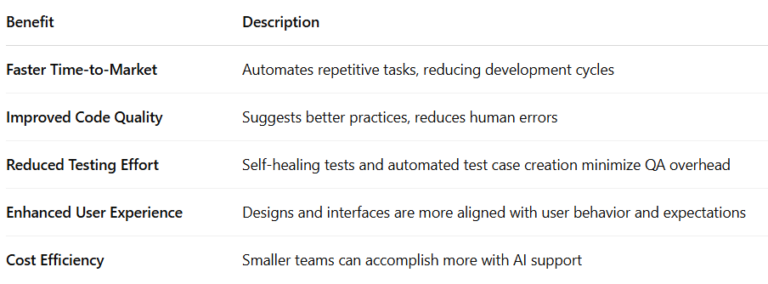Artificial Intelligence (AI) is no longer a distant concept it’s now embedded in our daily digital experiences. From content recommendations to virtual assistants, AI is at the core of many modern applications. One of the most transformative impacts of AI is in web development, where it’s automating testing processes, accelerating coding workflows, and even assisting in UI/UX design.
As businesses and developers seek faster time-to-market, higher-quality outputs, and smarter web solutions, AI emerges as a powerful ally. This article takes a deep dive into how AI is revolutionizing testing, coding, and design in the web development lifecycle.
AI in Web Testing: Intelligence Beyond Automation
1. Smarter Test Case Generation
AI has elevated automated testing by moving beyond rule-based scripts. AI algorithms analyze user flows, historical bugs, and application architecture to suggest the most effective test scenarios.
For example, Testim.io uses machine learning to create dynamic test cases that adapt to UI changes, reducing flaky test results and maintenance costs. These tools record user interactions and use them to generate reusable test flows.
2. Self-Healing Tests
In traditional automation, even a minor UI change (like a new class name or altered DOM structure) can break the test. AI-enabled tools detect such changes and automatically update the test scripts. This “self-healing” behavior ensures test continuity and reliability.
Example Tools:
Mabl – Tracks UI changes and adapts tests accordingly
Functionize – Uses NLP and ML to run autonomous tests
3. Regression Testing Made Easy
AI models can compare past and present versions of the app visually and functionally. Visual AI testing tools like Applitools Eyes detect UI discrepancies by comparing images pixel-by-pixel with deep learning models, eliminating the need to manually verify every change.
4. Risk-Based Testing
AI analyzes past test coverage, bug history, and feature changes to identify high-risk areas in the application. This prioritization ensures that critical functionality is tested first, especially under tight deadlines.
AI in Coding: Intelligent Assistance for Developers
1. AI Code Completion and Generation
AI code assistants, like GitHub Copilot, trained on billions of lines of code, can autocomplete functions, write repetitive code blocks, and even generate full modules. Developers only need to provide a brief description or a few lines, and the AI does the rest.
Use Case:
Writing a RESTful API? Copilot can suggest the entire route definition, middleware setup, and database query.
Other Tools:
Tabnine: Offers real-time AI suggestions across multiple languages
Amazon CodeWhisperer: Tailored for AWS developers with smart API integration
2. Bug Detection and Optimization
AI tools review code for performance bottlenecks, syntax errors, and vulnerabilities. They not only flag issues but recommend optimized alternatives.
For example, DeepCode and SonarQube use AI to scan repositories and suggest code improvements based on best practices and past error patterns.
3. Low-Code and No-Code Platforms
AI-powered low-code platforms like OutSystems and Bubble allow users with minimal coding skills to build full-fledged applications by dragging and dropping components. AI helps fill the logic gaps by generating the underlying code.
4. Natural Language to Code (NL2Code)
This is one of the most exciting developments in AI coding. Tools like OpenAI Codex allow developers to write prompts like:
“Create a Node.js Express route that fetches users from MongoDB”,
and the system responds with complete, functional code.
This drastically lowers the learning curve and improves accessibility for non-programmers and junior developers.
AI in Design: Enhancing Creativity and User Experience
1. Automated UI/UX Generation
AI design tools like Uizard, Figma AI, and TeleportHQ can turn wireframes or text descriptions into full design mockups. These tools analyze common patterns and aesthetics to create visually appealing layouts automatically.
Example Prompt: “Design a mobile app onboarding screen with a progress bar and welcome message.”
Within seconds, the AI generates a layout consistent with modern UX trends.
2. Personalized and Adaptive Interfaces
AI helps tailor web interfaces based on real-time data like user behavior, device type, or location. This personalization leads to higher engagement.
Example:
E-commerce platforms use AI to rearrange product displays based on user interaction history. If a user often shops for electronics, AI can prioritize those items on the homepage.
3. Data-Driven Design Decisions
AI-powered analytics tools like Hotjar and Crazy Egg provide heatmaps and behavior tracking. Designers use this data to refine layouts and CTAs (calls to action) based on actual user behavior rather than assumptions.
4. A/B Testing Automation
Instead of manually setting up A/B tests, AI tools can run multiple variations of a webpage, analyze which performs better, and automatically adjust the site to reflect the optimal version.
Benefits of AI in Web Development

Challenges and Limitations
Despite its advantages, AI in web development comes with a few caveats:
Over-Reliance on AI: Excessive dependence can weaken developers’ core skills.
Security Risks: AI-generated code may introduce vulnerabilities if not reviewed.
Ethical Concerns: Content generation and personalization must respect privacy laws and user consent.
Data Dependency: The quality of AI output depends heavily on the data it’s trained on. Biased data can lead to flawed suggestions.
The Future of AI in Web Development
AI is still evolving. In the near future, we expect:
AI-assisted debugging that explains logic flaws in human-readable form
Full-stack AI developers capable of building and deploying apps from natural language commands
Hyper-personalized design experiences updated in real-time with predictive AI
Voice-assisted coding integrated into IDEs for hands-free development
The fusion of AI and web development will not eliminate the role of humans—it will augment human capabilities and shift their focus to strategic, creative, and ethical dimensions of development.
Conclusion
AI is a game-changer in the field of web development. Whether it’s automating exhaustive testing processes, helping developers write better code faster, or enhancing UI/UX design, AI is paving the way for a smarter, more efficient development process.
As the tools mature and adoption grows, teams that embrace AI today will build the next generation of faster, safer, and more user-centric digital experiences tomorrow.
